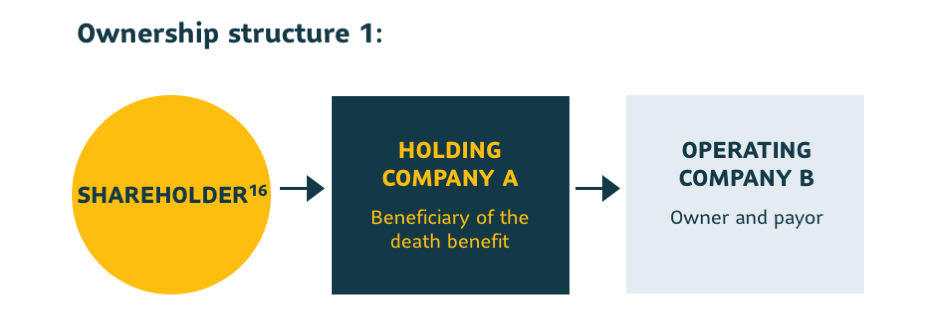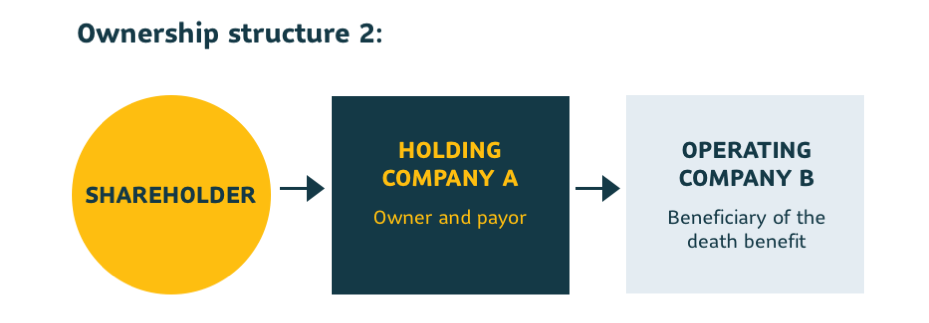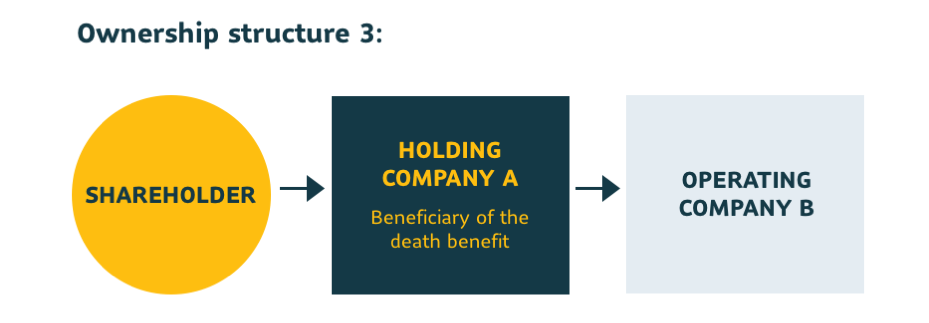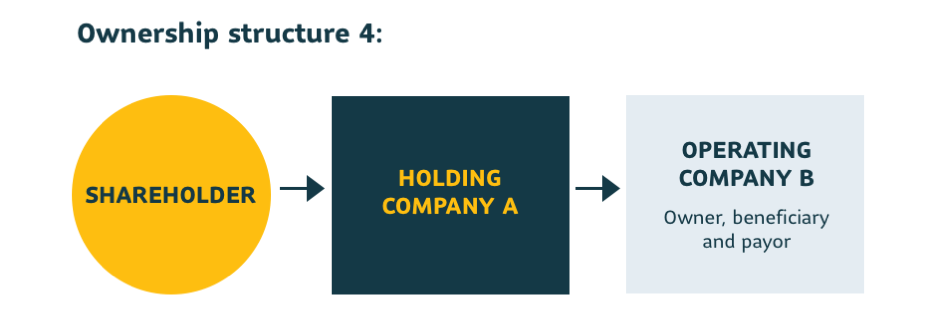
© Sun Life Assurance Company of Canada. All rights reserved.
Life insurance has long been used as a financial and estate planning tool for business owners. Whether it's help to cover a tax liability at death, to ensure adequate funding for a shareholders' agreement, or to put a capitalization program in place for a shareholder's policy, a life insurance policy will often be purchased by a corporation or a group of corporations, or even a trust. In certain situations, there are specific rules around choosing the owner, premium payor and beneficiary of the policy that must be followed to avoid unexpected – and undesired – tax and legal repercussions. With that in mind, the purpose of this document is to outline how life insurance can be used as a financial and estate planning tool for business owners.
There are a number of business reasons that might justify corporate ownership of a life insurance policy. Generally, corporate ownership of insurance will, if the applicable rules are followed, produce definite advantages from a financial, tax and legal perspective. These advantages, which we’ll look at in more detail later in this document, include the ability to utilize the capital dividend account (CDA), protection for the policy against creditors, streamlined policy management, a more equitable sharing of premium payments, and reduction of the tax cost of the premium.
While these are valuable benefits, certain tax rules must be satisfied in order to get the most out of them. In some situations, and specifically where a group of companies is involved, it’s important to clearly establish who will be the policy owner, who will be the beneficiary for the death benefit, and who will pay the premium. This step is critical, because if life insurance is not placed in the correct manner, there may be unfavourable financial and tax implications.
One of the most important considerations around life insurance in a business context is determining how ownership of the policy will be structured. In simple terms, the question comes down to whether a shareholder should own his or her life insurance policy personally, or have a corporation own it. To answer this question, the following are some key points to consider with regard to corporate ownership options for life insurance.
Whether a life insurance policy is owned personally or through a corporation, the premiums are generally not deductible1 from the income of the premium payor2. The payor's tax rate will therefore determine the real after-tax cost of the premium. In that context, it may be advantageous for the policy to be owned and the premium paid by a corporation, which will often have a more favourable tax rate than its shareholder. For example, an insurance premium of $5,000 per year paid personally by a shareholder with a 50% marginal tax rate will require an outlay of $10,0003 after tax. By contrast, the same premium paid by a corporation with a tax rate of around 17%4 will require an outlay of only $6,024 after tax. This means that for the same insurance premium, an annual savings of $3,976 will be generated where the corporation owns the life insurance policy. As life insurance is usually in place for many years, these savings can add up to a substantial amount over time.
1 Pursuant to paragraph 18(1)(b) Income Tax Act (ITA).
2 There is only one exception to this rule, and that is where a taxpayer borrows for the purpose of producing income and must assign the insurance policy to a creditor as collateral for the loan. Deduction of the premium will be possible only if all the conditions of paragraph 20(1)(e.2) ITA are satisfied.
3 The formula for calculating real after-tax cost is as follows: Premium in $ / 1 - (% marginal tax rate)
4 Federal /provincial tax rate for an SMB in the primary and manufacturing sector on the first $500,000 of active business income.
Where there is a significant age difference between two shareholders, or a shareholder is rated due to a health issue, personal ownership of a policy puts financial pressure on the individual who has to pay the higher premium. For example, it could come up in a buy-sell agreement where two business owners have agreed to buy each other's shares at death, and therefore need to own life insurance on each other's lives. Over the years, this situation could lead to a sense of unfairness for the shareholder.
To resolve this, corporate ownership of the policy and payment of the premium makes it possible to share the premium payment to be assumed by each of the shareholders in proportion to their respective interest in the company.
When life insurance policies are owned personally by shareholders, it may be difficult to determine whether each one is paying the required premium. This problem is magnified when a corporation has a large number of shareholders. The issue often comes to light when a shareholder dies, and it can pose a serious threat to funding for a buy-sell agreement in the event of death.
Corporate ownership eliminates this concern, as each shareholder has access to the corporation's minute books and financial statements, and can regularly validate the status of insurance policies in place.
In a situation where there are multiple shareholders, there is a significant risk of confusion with regard to their various life insurance policies. For example, in a personal ownership scenario, the number of life insurance policies that would be required for four shareholders would be 12 individual contracts (4 shareholders x 3 contracts) . In a corporate ownership scenario, only four life insurance policies would be required (one for each shareholder). In addition, policy fees would be lower with corporate ownership, and a better premium rate might be available given that the face amount of each individual policy would be higher.
The Capital Dividend Account (CDA)5 is part of the system of integration in the Income Tax Act (ITA)6.
One of the key advantages of corporate ownership of life insurance is the ability for the shareholders to receive tax-free dividends through the CDA, as stated in paragraph (d) of the definition of "capital dividend account" in subsection 89(1) ITA. Under this provision the net proceeds of a life insurance policy will be added to the CDA of a private corporation.
The expression "net proceeds" is defined as the amount of the life insurance policy proceeds received as a consequence of the death of the person insured minus the adjusted cost basis (ACB) of the policy immediately before the death of the person insured.
Example:
A private corporation7 is the beneficiary of a life insurance policy with a death benefit of $1,000,000.00. The ACB of the policy at the time of the insured shareholder's death is $150,000. The amount that will be credited to the corporation's CDA is $850,000 ($1,000,000 - $150,000). This amount can be paid tax-free to the shareholders of the corporation as a capital dividend. The balance of $150,000 can be paid to the shareholders as a taxable dividend.
Multiple corporations and the CDA
The Canada Revenue Agency (CRA) has consistently taken a position against arrangements designed to unduly exploit the preferential treatment accorded to the CDA where a corporation receives life insurance proceeds8. Certain life insurance ownership structures previously allowed corporations to receive the full death benefit as a credit to their CDA, without a corresponding reduction for the policy's ACB.
This was often accomplished by having a holding company own the policy, but then designating an operating company as the beneficiary of the life insurance proceeds. Because the operating company did not own the policy, it could claim the full death benefit as a CDA credit without a reduction for the ACB of the policy.
The 2016 federal budget ended this practice for deaths occurring on or after March 22, 2016. As a result, the death benefit is now reduced by the ACB for purposes of calculating the CDA credit, regardless of the structure in place for corporate ownership of the life insurance policy.
The 2016 federal budget also proposed the introduction of an information-reporting mechanism that will apply where a corporation or partnership is not a policyholder but is entitled to receive a benefit under the policy. Over the years, the CRA has often expressed opposition to two separate corporations being designated as policyholder and beneficiary solely to benefit from the CDA. The new reporting requirement will enable the CRA to detect this type of situation at the outset, without having to wait until the CDA is calculated at the time of the insured person’s death.
Creditor protection for the policy
Subject to the exceptions provided for in the Bankruptcy and Insolvency Act and provincial Insurance Acts9, a life insurance policy that has a cash surrender value constitutes an asset that can generally be seized by the policy owner's creditors. For example, a policy owned by a corporation will form part of the corporation's assets and the cash surrender value of the policy could be seized by the trustee in the event of bankruptcy. Furthermore, if the insurance was purchased to fund a shareholders' agreement, the death benefit payable to the corporation on the death of one of the shareholders could be subject to the claims of the corporation's creditors. Certain corporate ownership structures can be put in place to guard against this risk.
Where a corporation is the owner of a life insurance policy, the policy is protected from the shareholders' personal creditors or from legal proceedings against one of the shareholders10. The insurance policy could also be owned by a holding company that is, in turn, a shareholder of an operating company. Under this policy ownership structure, it is possible for the policy to be protected against the creditors of the operating company, as long as the holding company is not the guarantor of any of the operating company's obligations. The segregated funds in a registered products like RRSP, RRIF provided NO protection against familial patrimony rules, if applicable. Finally, the segregated funds could be in the partition process in a divorce according to the matrimonial regime.
It must be kept in mind that this protection is not total, and it does not apply in all situations. For example, transferring funds into a life insurance policy or choosing a particular corporate ownership structure for a policy does not confer absolute protection against creditors, nor does it automatically make the policy exempt from seizure if the trustee is able to prove that the purpose of the transaction was to defeat the claims of creditors.11
When in doubt as to the legal risks relating to corporate ownership of life insurance, consult a legal advisor.
5 Subsection 89(1) of the Income Tax Act (ITA) defines various types of property and distributions including the contents of the Capital Dividend Account. In Quebec, paragraph b of section 570 of the Taxation Act (TA) refers to the ITA. CRA Interpretation Bulletin IT-66R6 reviews the inclusions in the CDA and the CDA mechanism.
6 Refer to the Capital Dividend Account tax guide published by Sun Life Financial for more information on this topic at: the-capital-dividend-account-en.pdf
7 CDA is not available for public corporations.
8 In particular by applying the General Anti-Avoidance Rule (GAAR). See CRA Technical Interpretation 2004-0065461C6, CRA Income Tax - Technical News No. 44 dated April 14, 2011, and CRA Technical Interpretation 2010-0371901C6.
9 Refer to the Bankruptcy and Insolvency Act, R.S.C. 1985, c. B-3 (BIA). In Quebec, the relationship between the owner and the beneficiary determines whether or not the policy is protected; see articles 2455, 2456, 2457 and 2458 of the Civil Code of Quebec (CCQ).
10 Subject to the lifting of the corporate veil and any personal guarantees given by the shareholders to the creditor, if applicable.
11 See the decision of the Supreme Court of Canada in Royal Bank of Canada v. North American Life Assurance Company and Balvir Singh Ramgotra, [1996] 1 SCR 325.
When setting up an ownership structure for life insurance within a group of corporations, where there are various possible combinations of policy owner, beneficiary and premium payor, the result could be taxable benefits or income inclusions for one or more of the corporations involved, depending on the particular structure.
Some years ago the CRA reviewed its position12 on whether a parent company (Holdco) can be the beneficiary of a death benefit where its subsidiary (Opco) is the policy owner and premium payor. The CRA takes the view that in such a situation, the result would be a taxable benefit to the parent company (Holdco) pursuant to subsection 15(1) ITA. This interpretation has applied since January 1, 2010, and for policies issued prior to that date, it applies as of January 1, 201113.
In other cases, for example, where the parent company (Holdco) pays the premiums relating to a policy on which the subsidiary (Opco) is the owner and beneficiary, the CRA could, depending on the facts of the matter, apply subsection 246(1)14, section 9 or paragraph 12(1)(x)15 ITA.
To better understand the scope of the tax provisions discussed above, it might be helpful to take a look at various options for structuring corporate ownership of life insurance in order to analyze the potential tax implications. The examples on the pages that follow illustrate some different ownership structures and their related tax outcomes.
Holding Company A: beneficiary
Operating Company B: owner and payor

This structure would trigger the application of subsection 15(1) ITA. This means that Holding Company A would have to report a taxable benefit equal to the amount of the premium if it does not include that amount in its taxable income. In addition, owning a life insurance policy with substantial cash values could result in another tax disadvantage for Operating Company B, specifically, the potential loss of the capital gains deduction to the shareholder on the sale of qualified small business corporation (QSBC) shares.
Further, if Operating Company B were sold and the insurance policy were transferred, that would trigger a disposition and possible policy gain for the corporation. This ownership structure might also result in some risk to the policy's cash values in the event of a lawsuit against Operating Company B or the corporation's bankruptcy.
Holding Company A: owner and payor
Operating Company B: beneficiary

Under this structure, Operating Company B is the beneficiary of the death benefit, while Holding Company A is the policy owner and payor. In this case, subsection 15(1) ITA would not apply.
a) If Operating Company B reimburses the premiums to Holding Company A
If Operating Company B reimburses the premiums to Holding Company A, section 9 and paragraph 12(1)(x) ITA would have to be analyzed to determine whether Holding Company A would be required to include in its income an amount equal to the premium reimbursement by Operating Company B.
Section 9 ITA states that a taxpayer's income for a taxation year from a business or property is the taxpayer's profit from that business or property for that year. Consequently, if Holding Company A receives each year the exact amount of the premiums paid to the insurer, barring a gain arising on surrender of the policy, no income will be generated and section 9 ITA would not apply to that structure.
The other provision that could be invoked by the CRA is paragraph 12(1)(x) ITA, which is broader and more general in scope than section 9 ITA. It states that amounts received (including in the form of a premium) from another person who earns income from a business or property must be included in computing the taxpayer's income. In that context, if the holding company has to include in its income a premium that is not otherwise deductible, the result would be double taxation. The risk relating to this provision would apply more specifically where a portion of the premium is deductible17.
It may be possible to prevent the potential application of paragraph 12(1)(x) ITA by paying a dividend in kind, which would have to be declared annually by Operating Company B to Holding Company A. There should also be a written agreement among the shareholders confirming that the dividend will be used to pay the premium to the insurer to keep the policy in force.
b) If Operating Company B does not reimburse the premiums to Holding Company A
If Operating Company B does not reimburse the premiums to Holding Company A, subsection 246(1) ITA could potentially apply, given that payment of the premium confers a benefit on Operating Company B.
The value of the benefit would have to be included in the taxable income of Operating Company B. The value of the benefit received by Operating Company B will depend largely on whether its beneficiary status is revocable or irrevocable. In the case of a revocable beneficiary designation, the value might possibly be very low, or even zero.
Lastly, where the corporations are dealing at arm's length and it is established that they have entered into a bona fide business transaction, subsection 246(1) ITA would not apply, pursuant to subsection 246(2) ITA.
Holding Company A: owner, payor and beneficiary
Operating Company B: Nil

This life insurance ownership structure does not result in a taxable benefit for corporations A and B, nor does it carry with it any particular risk in terms of creditor protection. With Holding Company A as the owner of the life insurance policy, a policy transfer can be avoided in the event Operating Company B is sold.
Holding Company A: nil
Operating Company B: owner, payor and beneficiary

This life insurance ownership structure does not result in a taxable benefit for corporations A and B. However, if the policy has a savings component, it may become an asset that taints the QSBC status of the shares for purposes of the capital gains deduction on the sale of the shares18.
In addition, the transfer of the ownership of the life insurance policy from the Operating Company B to the Holding Company A could give rise to tax consequences like a possible taxable policy gain for Operating Company B. This ownership structure might also carry with it some risk in terms of creditors, who could seize the policy's cash values in the event of a lawsuit against Operating Company B or the corporation's bankruptcy.
| OWNER | PAYOR | BENEFICIARY | REIMBURSEMENT OF PREMIUMS TO PAYOR | APPLICABLE SECTIONS (ITA) | CRA TAX POLICY |
|---|---|---|---|---|---|
| Operating | Operating | Holding | No | 15(1) | Benefit for Holding |
| Holding | Holding | Operating | Yes | 9 or 12(1)(x) | Possible income inclusion for Holding |
| Holding | Holding | Operating | No | 246(1) | Benefit for Operating |
| Holding | Holding | Holding | N/A | None | None |
| Operating | Operating | Operating | N/A | None | None |
12 See CRA Technical Interpretations 2004-0065461C6 and 2009-0347291C6.
13 In Quebec, Revenu Québec has applied this position since 2008.
14 Where the shareholders are dealing at arm's length, subsection 246(2) ITA renders subsection 246(1) ITA inapplicable, with the result that no benefit or income inclusion should arise.
15 See CRA Technical Interpretation 2010-0359421C6 dated May 4, 2010.
16 For all of the structures presented here, the shareholder owns 100% of the voting and participating shares of Holding Company A and the Holdco owns 100% of the voting and participating shares of Operating Company B.
17 See paragraph 20(1)(e.2) ITA.
18 According to the definition of "qualified small business corporation share" in subsection 110.6(1) ITA.
In cases involving a group of companies, it's not uncommon to find a trust as part of the shareholders' corporate structure. Trusts, which are considered a separate patrimony, are often used as a tax planning tool. Also, trusts can be useful if the goal is to provide protection for the policy, reduce probate fees at death, or to ensure effective tracking and management of funds generated by a corporation.
A trust can purchase and be the owner of a life insurance policy where permitted by the trust deed. Upon the death of the insured person, the death benefit will be paid to the trust as beneficiary of the policy and distributed in accordance with the trust deed.
One of the tax advantages of owning a life insurance policy through a trust is the fact that a life insurance policy is not eligible capital property under the ITA, and consequently, policies held by a trust are not affected by the deemed disposition of the trust property every 21 years. In addition, like any other trust property, a life insurance policy can be transferred to the beneficiaries of the trust capital with no tax impact, if the conditions of subsection 107(2) ITA are satisfied19. By contrast, a tax-free rollover of a life insurance policy owned by a corporation to a trust is not possible, as a life insurance policy is not eligible capital property within the meaning of section 73 ITA. Such a transfer would constitute a disposition under subsection 148(7) ITA and could trigger tax consequences.
Lastly, if a trust is the direct beneficiary of a death benefit, it cannot utilize the capital dividend account (CDA) mechanism, which is available solely to private corporations that are life insurance beneficiaries. Similarly, the CRA has clarified that life insurance proceeds received by a trust and then paid to a private corporation designated as a trust beneficiary cannot be included in the corporation's CDA20.
19 See CRA Technical Interpretation 2011-0391781E5. According to the CRA, this subsection takes precedence over subsection 148(7) ITA.
20 See CRA Technical Interpretation 2011-0399771C6.
The choice of a corporate ownership structure for a life insurance policy should be carefully documented and recorded in the form of a resolution in the corporation's minute books. The documentation should clearly state the business reasons21 that support the particular ownership structure selected. That way, in the event of a tax audit, there will be little risk of a diverging interpretation that could lead to undesirable tax repercussions.
21 Examples of business reasons: funding a shareholders' agreement, asset purification to ensure shares qualify for the CGD, desire to keep the policy following sale of the corporation, creditor protection, etc.
Despite the position taken by the CRA in 2010 and, more recently, in the 2016 federal budget, you still need to do the proper planning with clients when it comes to corporate-owned life insurance. As there is no one-size-fits-all solution, it's important that you evaluate clients' needs and situation in order to identify the most appropriate ownership structure. It's important also to encourage clients to consult their legal and tax advisors before settling on a specific ownership structure, especially in situations of greater complexity.
This document is intended to provide general information only. Sun Life Assurance Company of Canada does not provide legal, accounting or taxation advice to advisors or their clients. Before a client acts on any of the information contained in this document, or before you recommend any course of action, make sure that the client seeks advice from a qualified professional, including a thorough examination of their specific legal, accounting and tax situation, as required.
Sun Life Assurance Company of Canada is a member of the Sun Life Financial group of companies.
Want to share this information on social media? Select the appropriate link below.

© Sun Life Assurance Company of Canada. All rights reserved.
